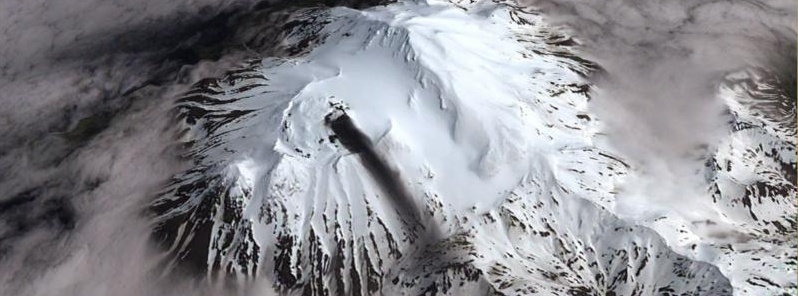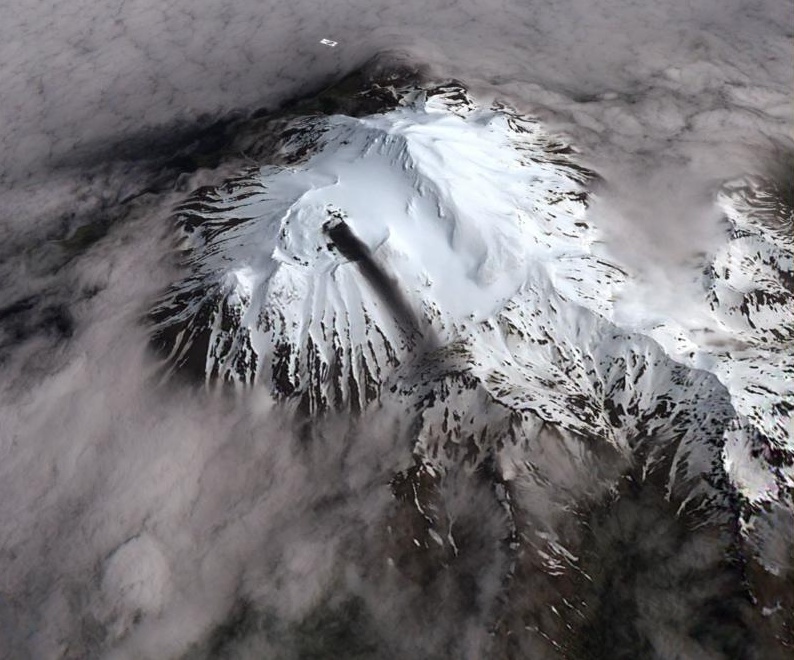Elevated seismicity under Great Sitkin volcano, alerts raised again, Alaska

The Alaska Volcano Observatory raised the Aviation Color Code and Alert Level for Great Sitkin stratovolcano to Yellow/Advisory on July 1, 2018, following another increase in the number of earthquakes under the volcano. The last known eruptive episode of this volcano took place from February 19, 1974 to September 16, 1974 (+/- 15 days). It had Volcanic Explosivity Index of 2.
Earthquake activity at Great Sitkin Volcano has increased above background levels over the past day, AVO reported 19:58 UTC on July 1, 2018.
Numerous small, shallow earthquakes are occurring beneath the summit at rates as high as 10 to 20 per hour, AVO scientists said. It is uncertain if this unrest will lead to any eruptive activity, but this remains a possibility given the general degree of unrest at Great Sitkin over the past several months.
A brief steam and ash explosion was detected at Great Sitkin volcano on June 10, following 5 days of elevated seismicity. AVO raised the Aviation Color Code and Alert Level to Yellow/Advisory on the same day and lowered back to Green/Normal on June 26, after earthquake activity declined to background levels over a period of about 2 weeks.
Over the past several days, nothing significant has been observed in satellite data and no other signs of unrest have been detected or reported to AVO.

Sentinel-2 satellite image of Great Sitkin acquired on June 11, 2018 at 23:00 UTC showing an ash deposit extending for about 2 km to the southwest. Ash was likely deposited during the brief explosion on June 10, 2018. Minor steaming from a vent through the 1974 lava flow is also visible in this image. View is from the southwest. Image credit: ESA Sentinel-2; Schneider, David
Great Sitkin Volcano is monitored by a five-station seismic network on Great Sitkin Island and with additional seismic stations on the nearby islands of Igitkin, Adak, Kagalaska, and Kanaga. A six-element infrasound array to detect explosions (atmospheric pressure waves) was installed on Adak Island in June 2017, although it is currently (June 2018) only partly operational. AVO also uses satellite imagery to monitor Great Sitkin Volcano.
This volcano forms much of the northern side of Great Sitkin Island. A younger parasitic volcano capped by a small, 0.8 x 1.2 km (0.5 – 0.7 miles) ice-filled summit caldera was constructed within a large late-Pleistocene or early Holocene scarp formed by massive edifice failure that truncated an ancestral volcano and produced a submarine debris avalanche. Deposits from this and an older debris avalanche from a source to the south cover a broad area of the ocean floor north of the volcano. The summit lies along the eastern rim of the younger collapse scarp.
Deposits from an earlier caldera-forming eruption of unknown age cover the flanks of the island to a depth up to 6 m (20 feet). The small younger caldera was partially filled by lava domes emplaced in 1945 and 1974, and five small older flank lava domes, two of which lie on the coastline, were constructed along the northwest- and NNW-trending lines.
Hot springs, mud pots, and fumaroles occur near the head of Big Fox Creek, south of the volcano.
Historical eruptions have been recorded since the late-19th century.
Featured image credit: ESA Sentinel-2, David Schneider

Commenting rules and guidelines
We value the thoughts and opinions of our readers and welcome healthy discussions on our website. In order to maintain a respectful and positive community, we ask that all commenters follow these rules:
We reserve the right to remove any comments that violate these rules. By commenting on our website, you agree to abide by these guidelines. Thank you for helping to create a positive and welcoming environment for all.